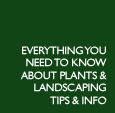Soil Conditions
It is extremely important that you know your soil conditions before you start any type of landscape planning, for two reasons.
Reason #1 - pH Levels
First and foremost you must know the pH level of your soil, as some plants thrive in acidic soil and others will not do well. Plants that need acidic soil will not do well in alkaline
conditions. The pH scale (measuring 1-14) is used to measure acidity, the term pH referring to the hydrogen ion concentration in the soil. A pH of 7 is neutral, below 7 indicate an
acidic soil.
Here is a quick and easy pH test you can use at home:
- To check whether your soil is severely alkaline, take a teaspoon of dry garden soil and add a few drops of vinegar. If the soil fizzes, the pH is above 7.5 (the free carbonates
in the soil react with the acidity at a pH of 7.5 and above).
- To check for acidity in the soil, take a teaspoon of wet soil and add a pinch of baking soda. If the soil fizzes, the soil is probably very acidic (pH less than 5.0).
In most cases in Southern Ontario , a hard clay soil is on the alkaline side of the spectrum and sandy soil is typically more acidic. This is a generalization, having your soil tested
is the best way to know your particular conditions. After determining the type of soil you have (whether alkaline, acidic or neutral), it is a good idea to add organic material, compost,
or triple mix to increase the nutrient content and nourish the plants.
Organic material, compost and triple mix will neutralize soil (but are necessary for their nutrients) so once you have added that you may need to re-create an acidic garden bed for
the acid-loving plant, by adding peat moss at the time of planting.
For example, even if you have acidic, sandy soil, you may need to add triple mix for its nourishing nutrients, even thought that will make the soil more neutral and then add peat moss
around those plants that want the extra acidity.
Or, on the other hand, you may have more clay than sand, but it may also read high acidity levels. This may be due to areas of high levels of acid rain or industrial pollution. Also,
some mature acidic trees will affect the acidity levels in the soil around them (the needles that drop from evergreen trees are acidic and the drip line around the tree over years will
add acidity).
As a general rule of thumb when creating a garden bed, always use organic material, compost or triple mix, no matter what th pH level of the soil is.
There are many different ways to add organic material to your garden. A composter in your back garden will produce fantastic, rich compost and eliminate waste from your kitchen (and
landfill sites _ ) A composter is one of the cheapest and purest ways of creating an ongoing supply of organic material. Most municipalities subsidize the cost to encourage people to
use them. You can get them at most garden centers. Alternatively, most garden centers also sell soil conditioners such as shrimp compost, mushroom compost and various types of manure.
NOTE:
Buying Manure from Farmers
Buying manure from a farmer tends to be less expensive than buying from your local garden center. However, only buy manure from organic farmers as there may be high levels of pesticides,
weed killer and urine in the manure of animals that are raised by non-organic farmers. This is a disadvantage instead of an advantage to your garden soil as you can not determine the
levels and your plants may become damaged.
Types of Organic Material
Cow/Pig Manure is termed as cold or wet manure because of its high moisture content. Although this can be to your advantage if you have sandy soil, decomposition may be slower in clay
because of its cooler soil temperature and higher moisture content. Having clay soil myself, I prefer to use cow manure instead of pig manure as cow manure is slightly dryer.
- Horse Manure
- is termed as hot manure because it produces heat when breaking down. It is very good for the production of warm soils (hot beds)
- Poultry Manure
- is very rich and will need storing and drying before use. I have often seen roots burnt because gardeners have used fresh poultry manure.
- Straw
- is used more as a soil conditioner and may be used on its own or in a compost heap with other materials.
- Spent Mushroom Compost
- is cheaper to buy than peat moss and can be used both on compost heap and as a coil conditioner.
In Ontario , the 2 main types of native soil gardeners will encounter with either be clay or sand:
- Clay
- In most cases, clay will feel heavy, wet and sticky and it will often be hard to work. It is sometimes called "cold soil" because it takes a long time to warm up in spring. Clay
belongs to a group of sticky paste substances called colloids and its small, closely stacked particles leave very few and small spaces in between, thus restricting the flow of air
and water. The spaces can become waterlogged and plants may die off in such air-less conditions.
- Sand
- Sand particles can be wither fine or coarse. The ideal soil for organic crops or gardens is one with a high percentage of fine sand, which is able to hold more moisture than a coarse
sand. If not supplied with large amounts of organic matter, the fine sand will dry out very quickly and offer very little in the way of plant nutrients. However, coarse sand plays a
very important part in the movement of air and water through the soil.
Reason #2 - Drainage
Another reason to know your soil conditions is drainage.
Drainage in the garden can be one of the biggest problems gardeners face. In heavy clay conditions, water generally will sit in low areas for long periods of time. Too much water can
water log plants and cause damage or death. Adversely, in sandy conditions, water can drain too quickly washing away nutrients which plants need to retail their health an vigor. It
can also dry roots too quickly causing a lack of water to the plants.
TIP: When the property was originally graded, it was designed for water to be removed away from the property to catch-basins or drainage areas. When constructing a garden
bed, your base soil and watering/drainage requirements must be considered. For example, if you excavate the soil too deeply for your garden bed in a clay-based property, you are essentially
changing the grade making that garden bed the lowest point and naturally the water will flow into it causing the garden to be constantly water logged, which causes undue stress and
eventually death to the plants. When constructing a garden bed in a clay-based property, remove only the sod and 2 inches of the clay. Elevate your garden bed with organic material
or triple mix to allow for better drainage.
TIP: This Do-It-Yourself Test will evaluate your water drainage (the ability of water to move through the soil) moving very slowly through clay and very quickly through sand.
- Dig several holes (1' deep by 2'wide) in various places in and around your garden. Just set that soil aside, so you can re-fill the holes after the test.
- Cover the holes with sheets of plastic to let the soil dry out.
- Once the soil is dry, fill each hole to the top of the water and time how long it takes for the water to completely drain.
The ideal time is between 10-30 minutes.
- If the water drains in less than 10 minutes, the soil will tend to dry out too quickly in the summer.
- If it takes 30 minutes to 4 hours to drain, you can still grow most plants but will have to water slowly to avoid runoff and to allow the water to soak in deeply.
- If your soil takes longer than 4 hours to drain, you may have a drainage problem. In sandy soil, dig down a foot or two to see whether a hard layer is blocking water movement.
If so, break it up. If your soil is dense clay, raise the whole bed to get your plants up out of the soggy soil and into well-drained, elevated soil.
|





